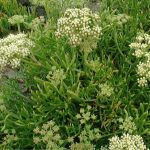| Common Name: |
Sea Fennel |
| Other Names: |
Samphire, Rock Samphire |
| Botanical Name: |
Crithmum maritimum |
| Genus: |
Crithmum |
| Family: |
Apiaceae |
| Native Location: |
Black Sea, Mediterranean, English Channel, and Atlantic coasts of Europe. |
| Cultivation: |
Well-drained to dry soil in sun. Needs a warm, sheltered position inland and protection in cold winters. |
| Propagation: |
By seed sown when ripe; by division in spring. Seeds lose viability rapidly. |
| Harvest: |
Whole plants are gathered in late spring and used fresh for infusions. Leaves and flowers are picked fresh for use as a vegetable. |
| Height: |
15-45cm (6-18in) |
| Width: |
15-45cm (6-18in) |
| Hardiness: |
Z7-9 |
| Parts Used: |
Whole plant, leaves, flowers. |
| Properties: |
A strongly aromatic, salty herb that has diuretic effects, cleanses toxins, and improves digestion. It has a reputation for encouraging weight loss. |
| Medicinal Uses: |
Internally for obesity, kidney complaints and sluggishness. |
| Culinary Uses: |
Leaves are eaten in salads, cooked in butter, or pickled in vinegar and used in similar ways to capers. Flowers are also eaten in salads. |
| Bibliography: |
Encyclopedia of Herbs by Deni Brown Copyright © 1995, 2001 Dorling Kindersley Limited Pg 183 |

